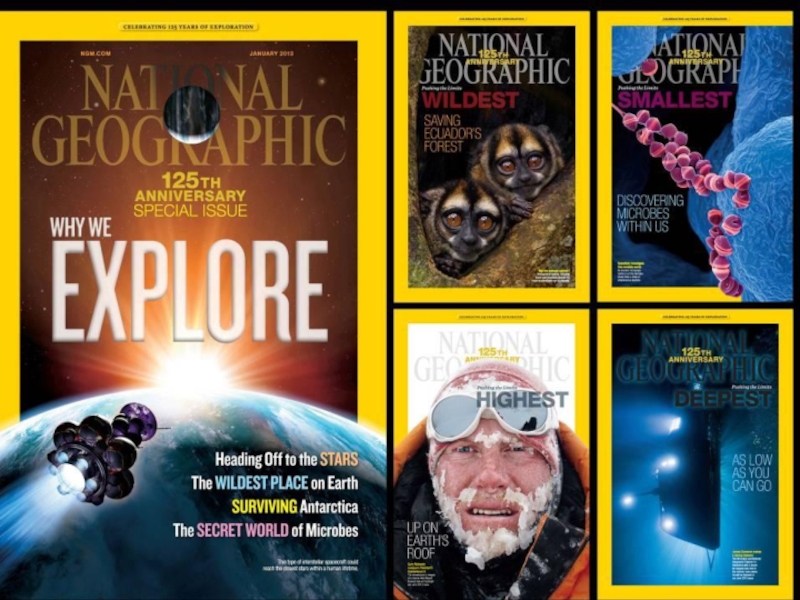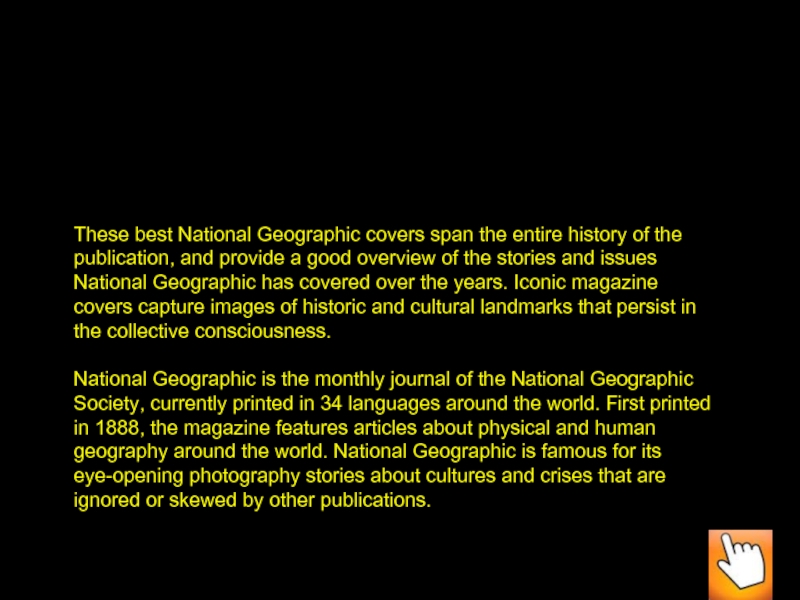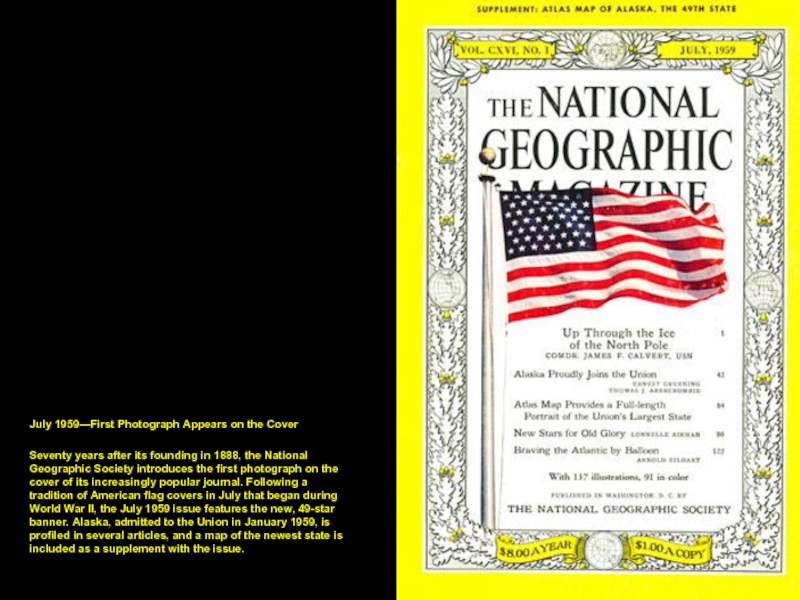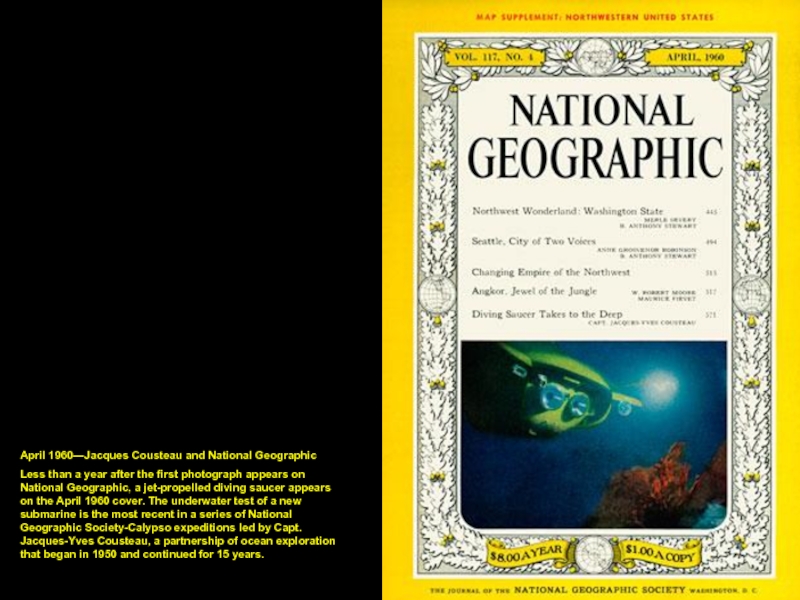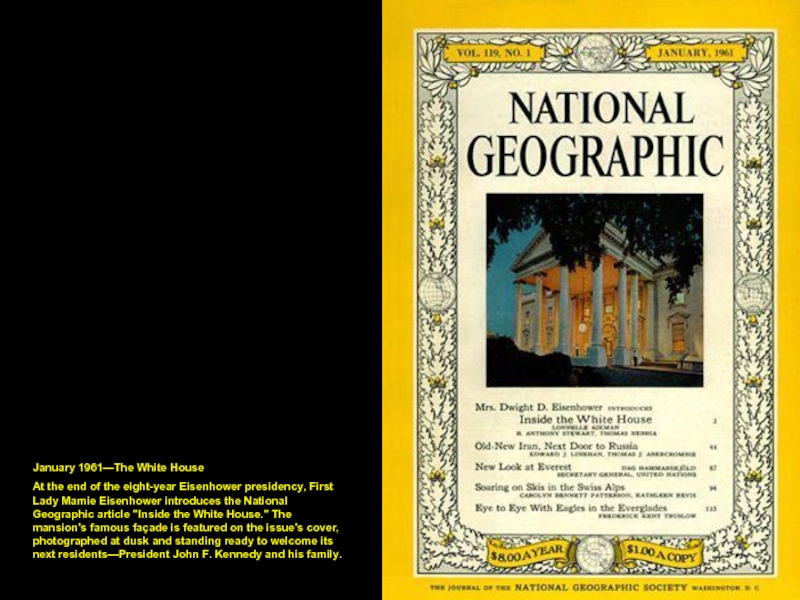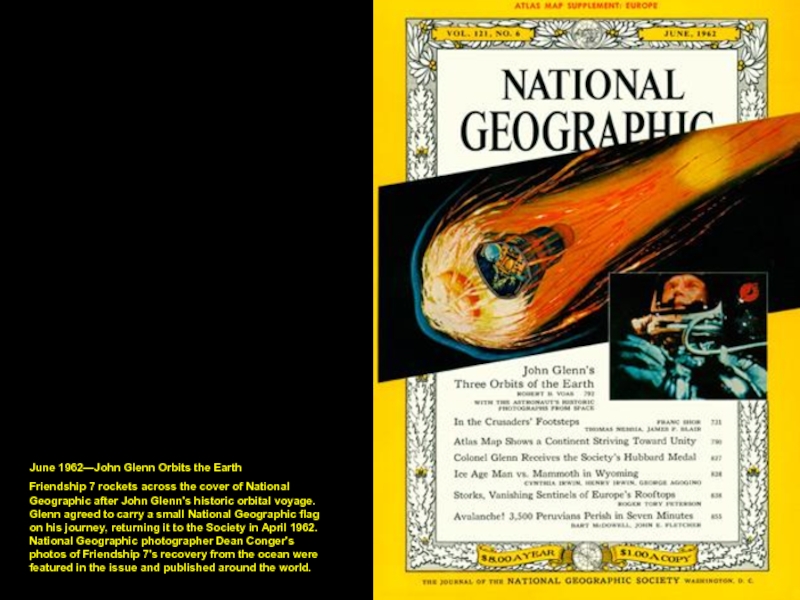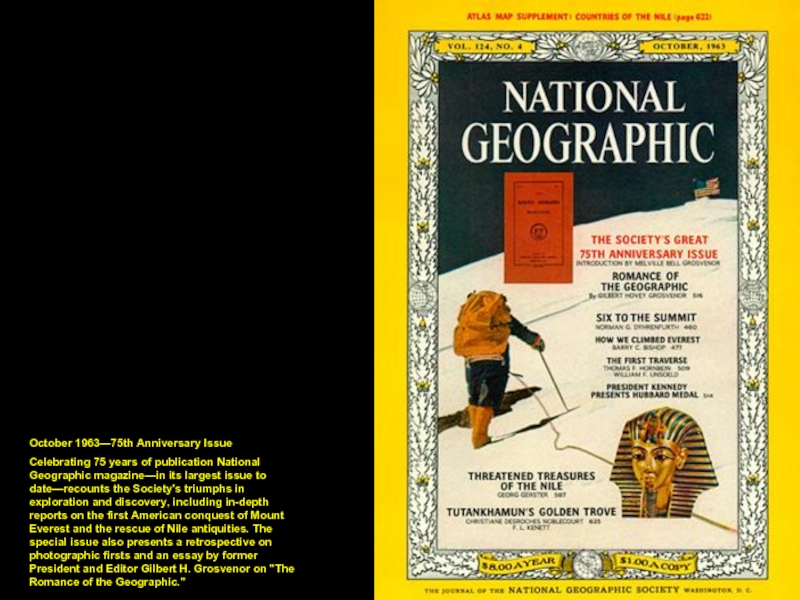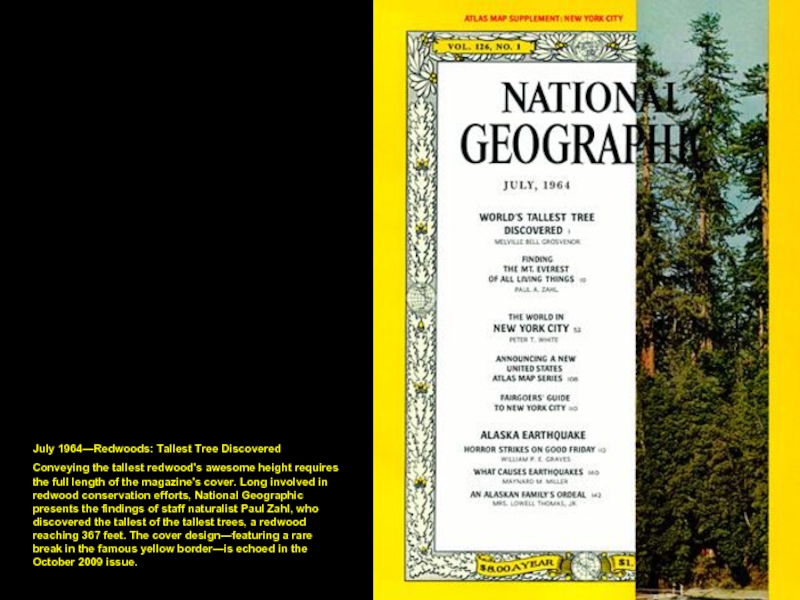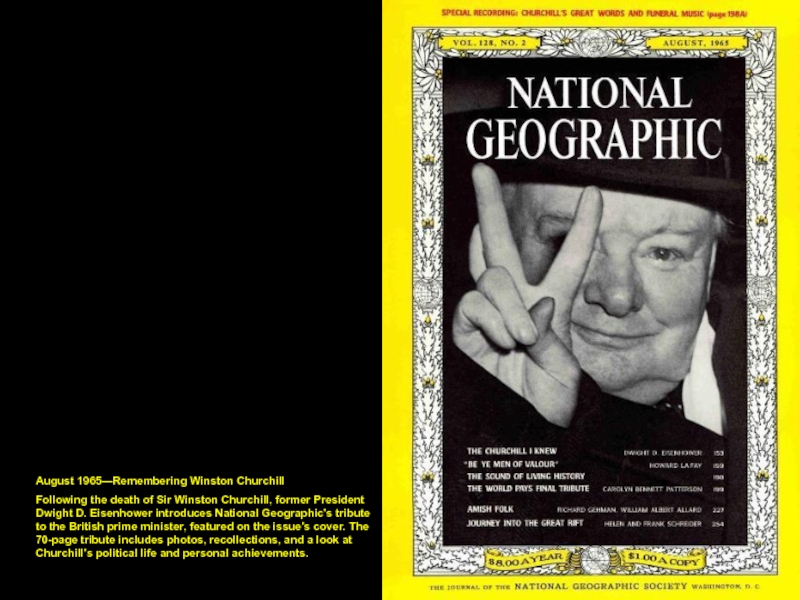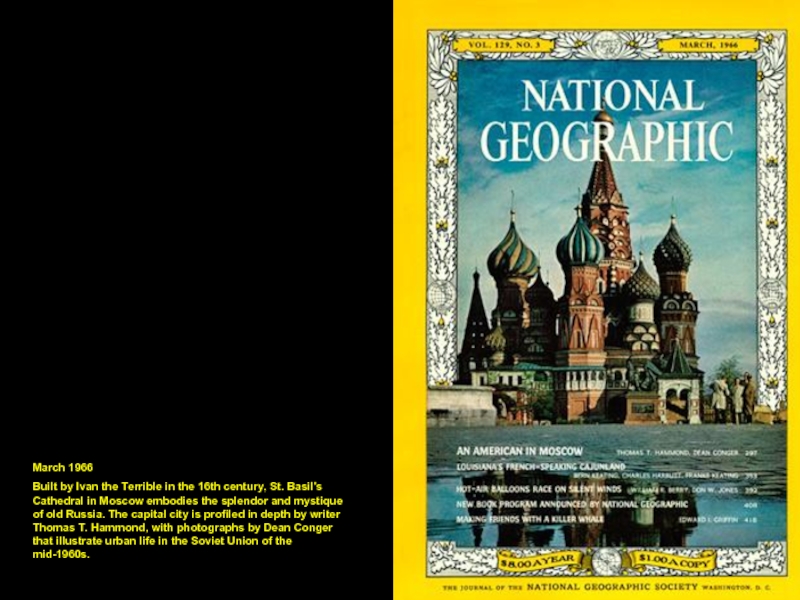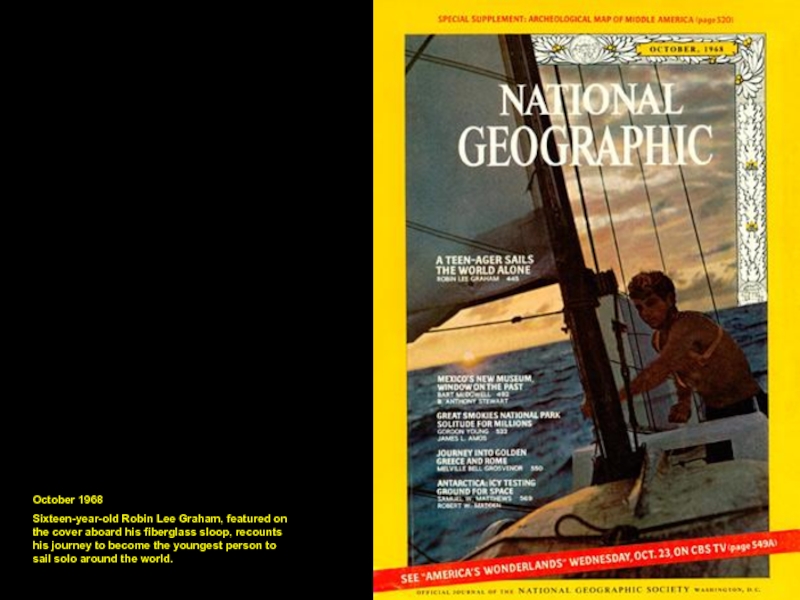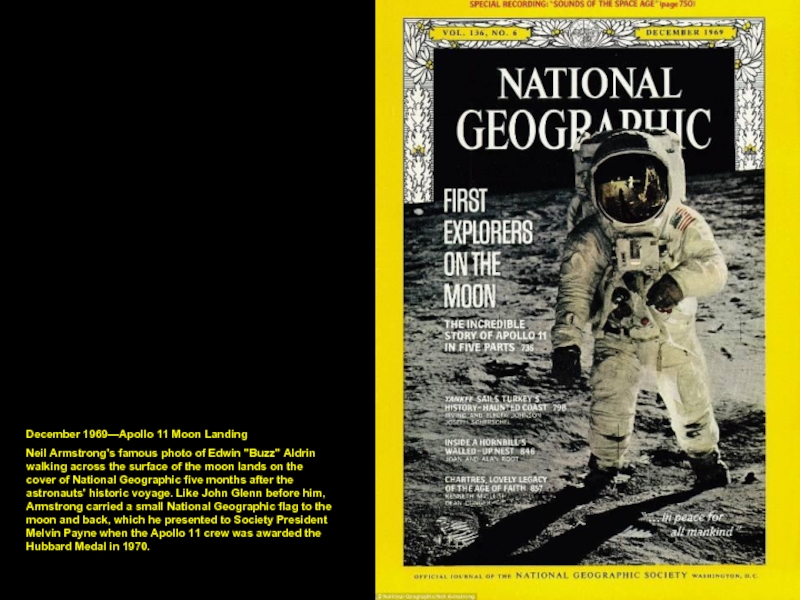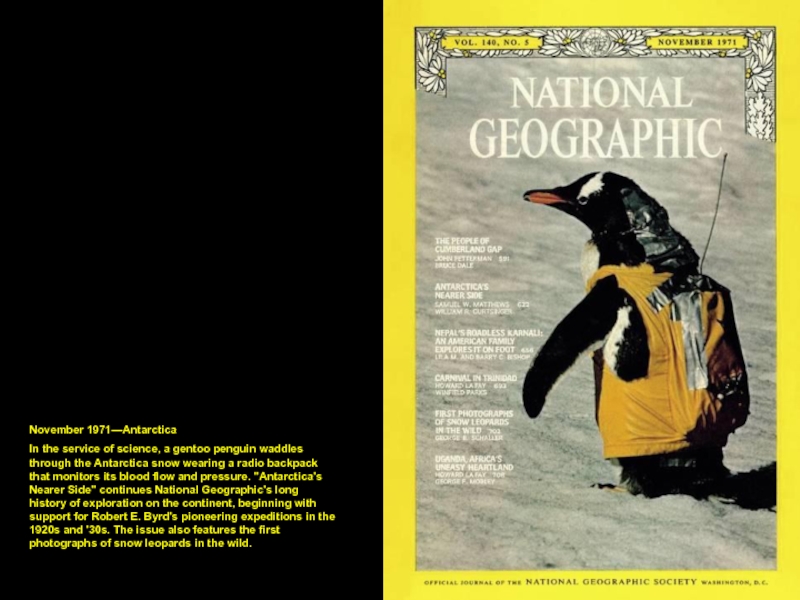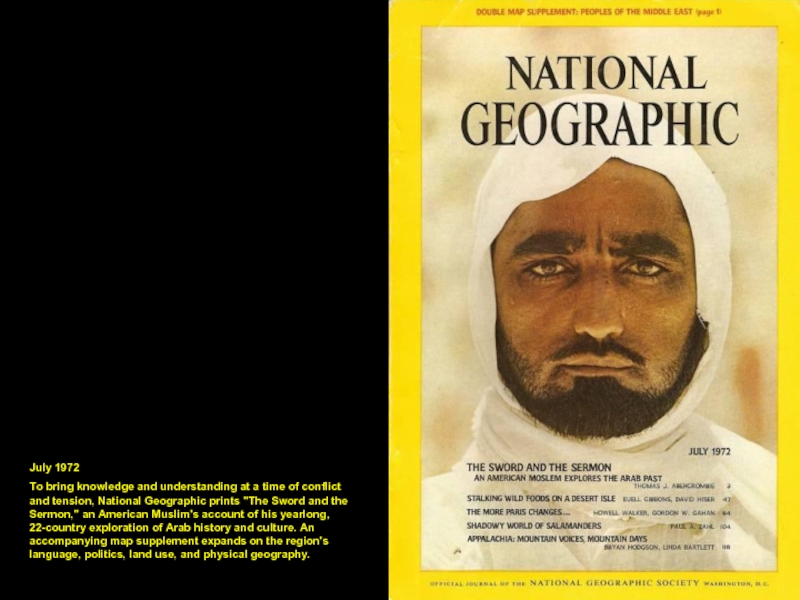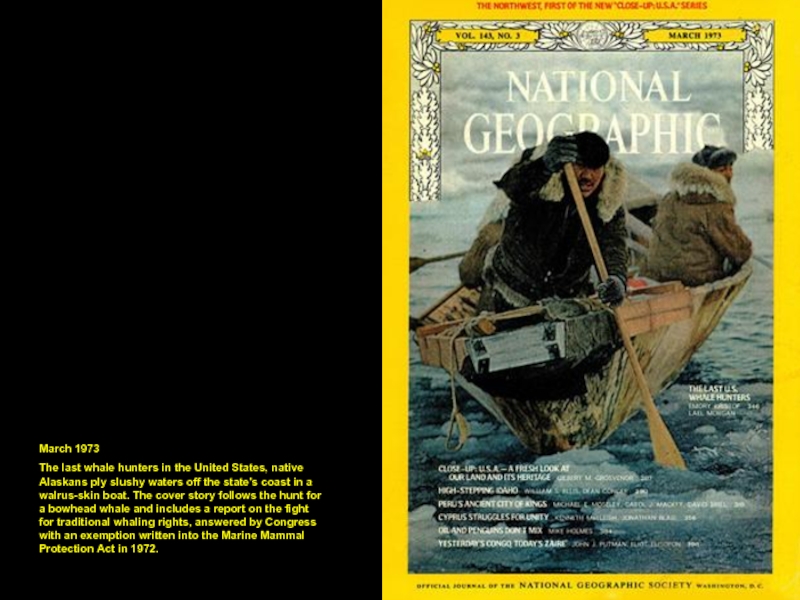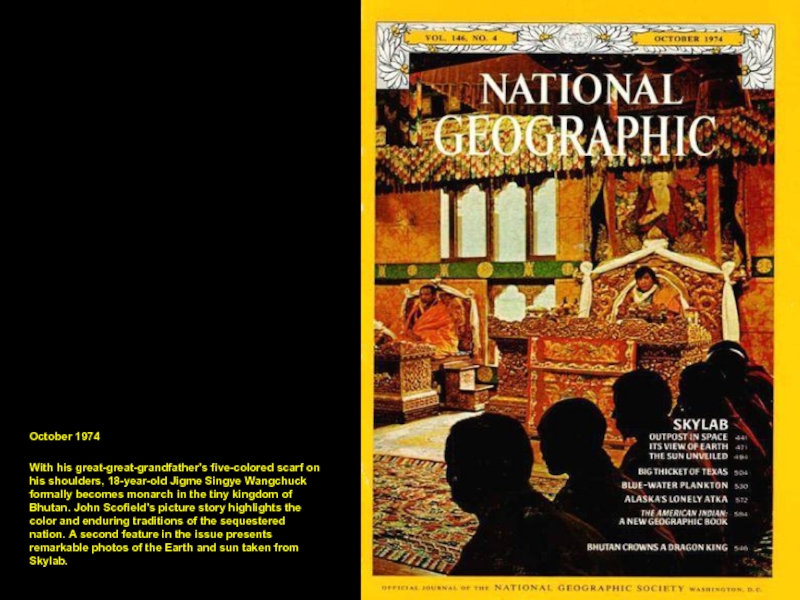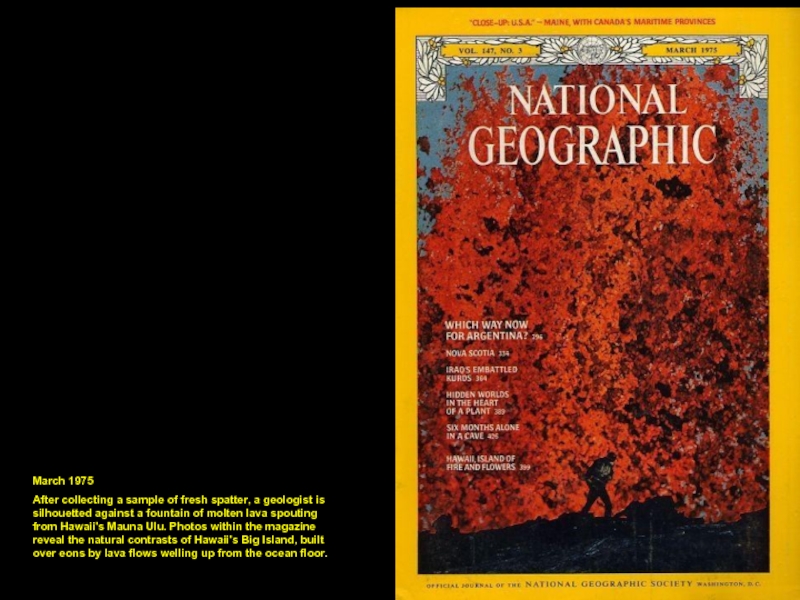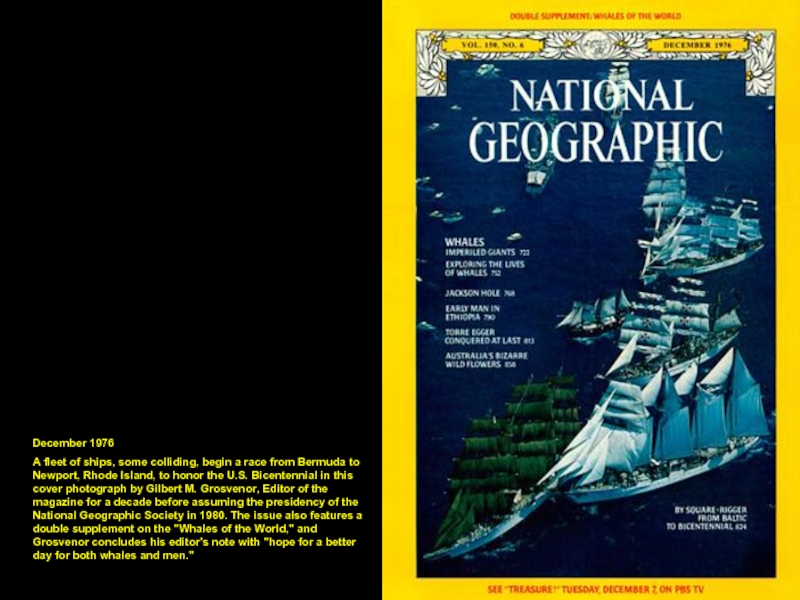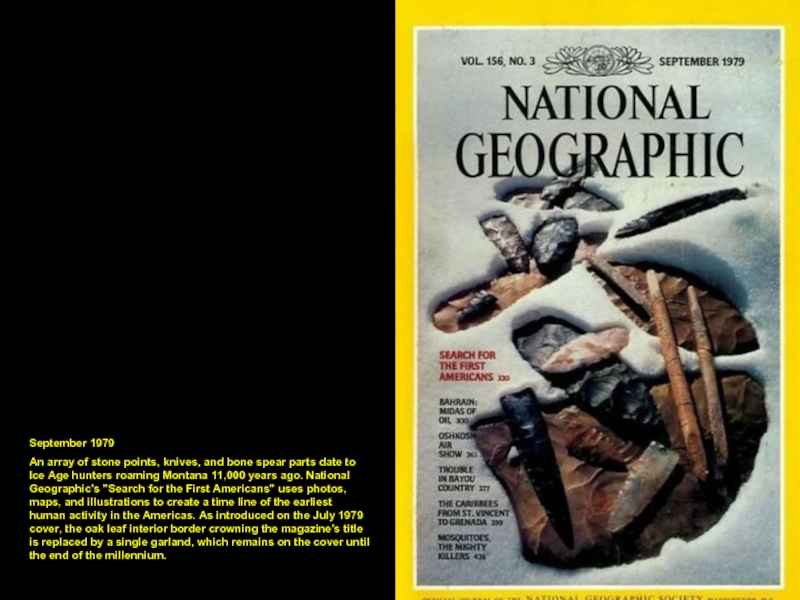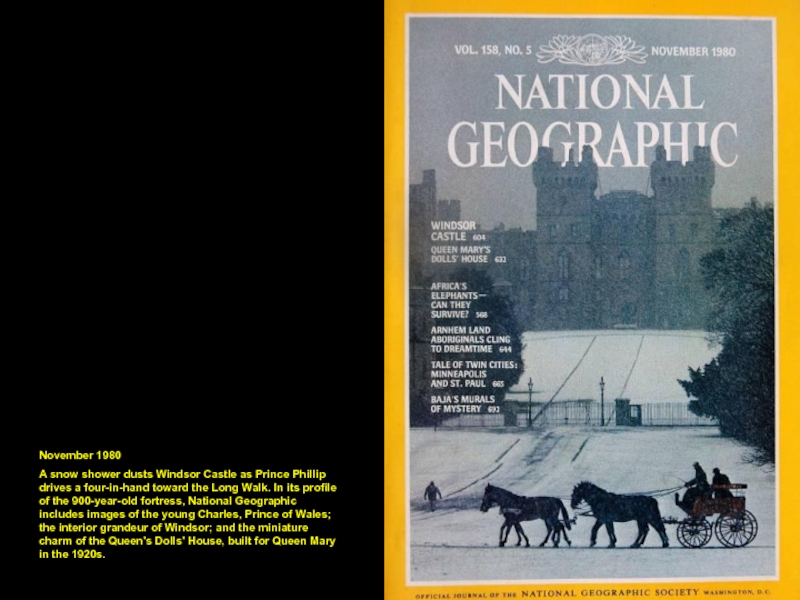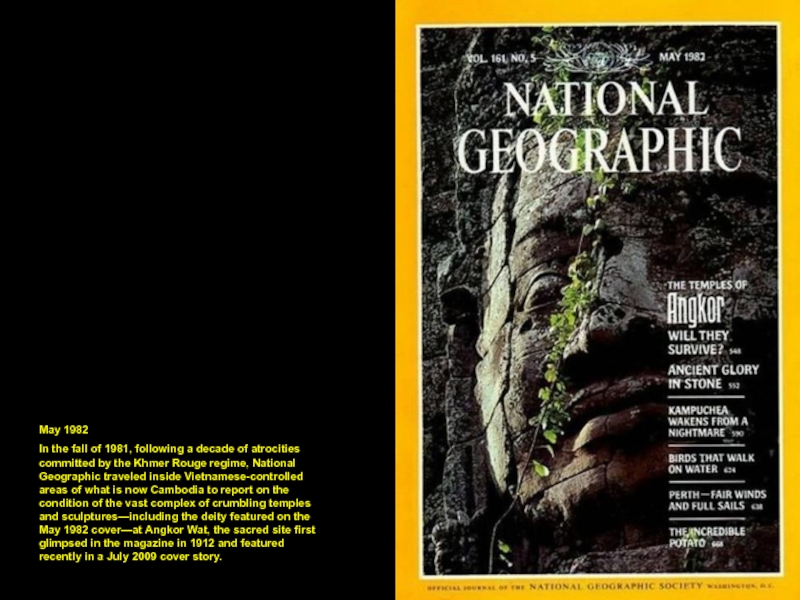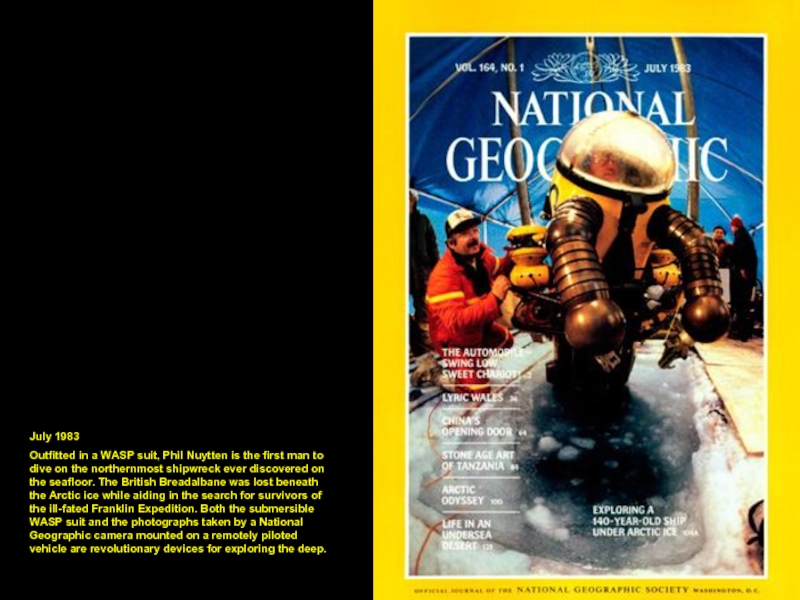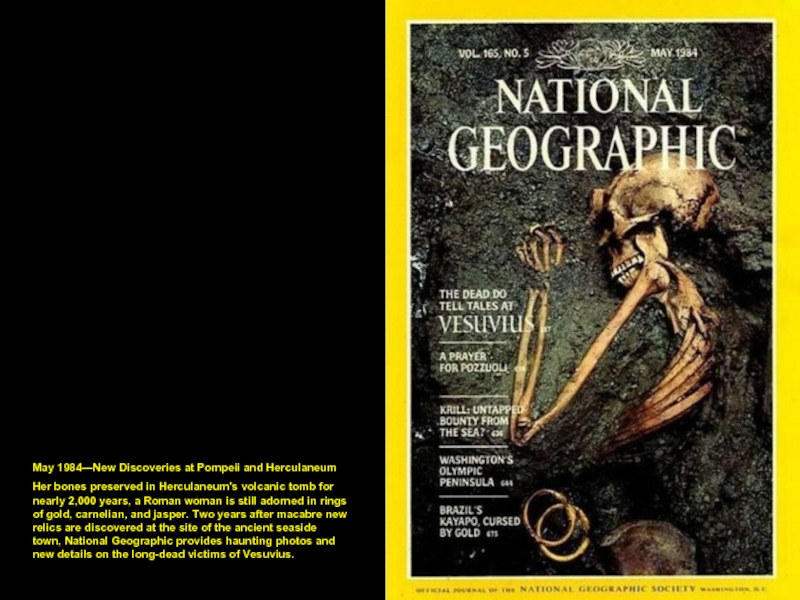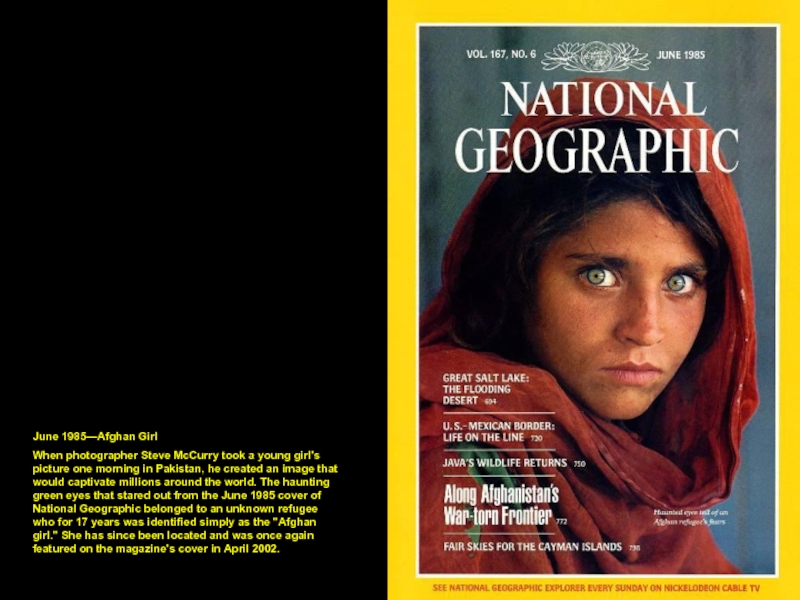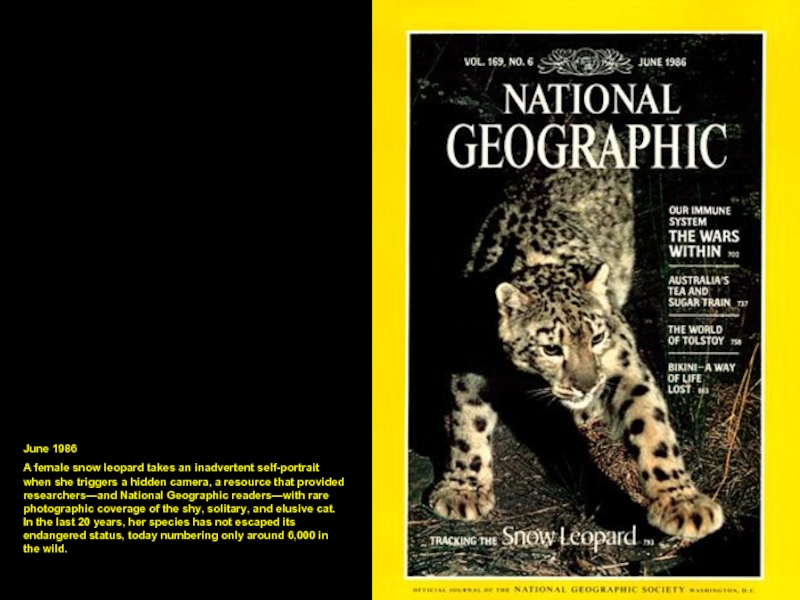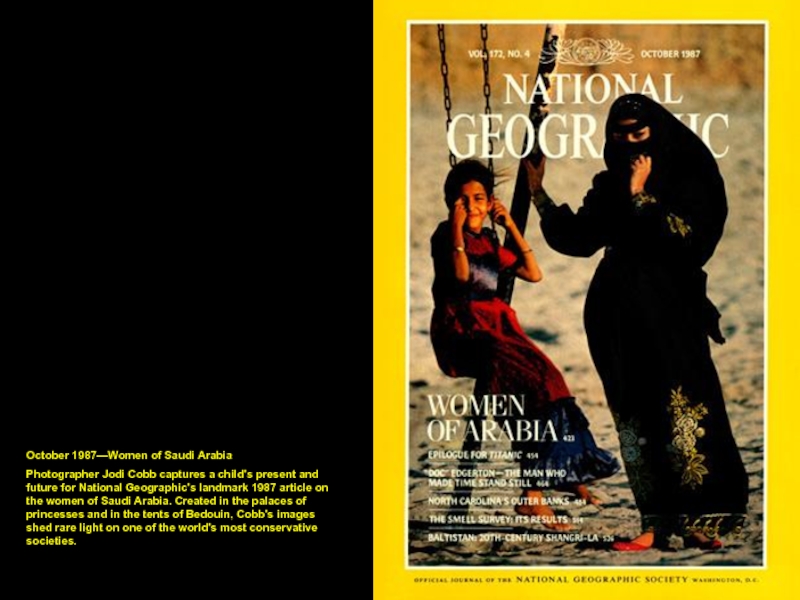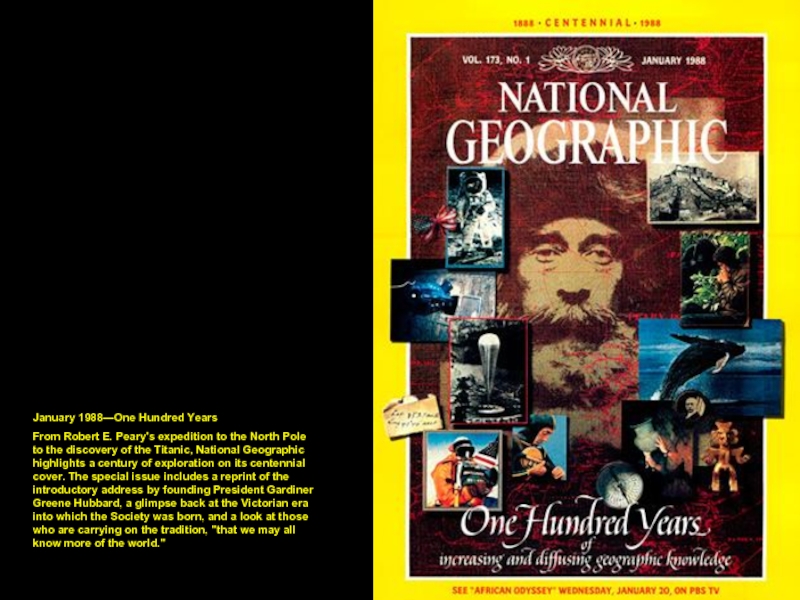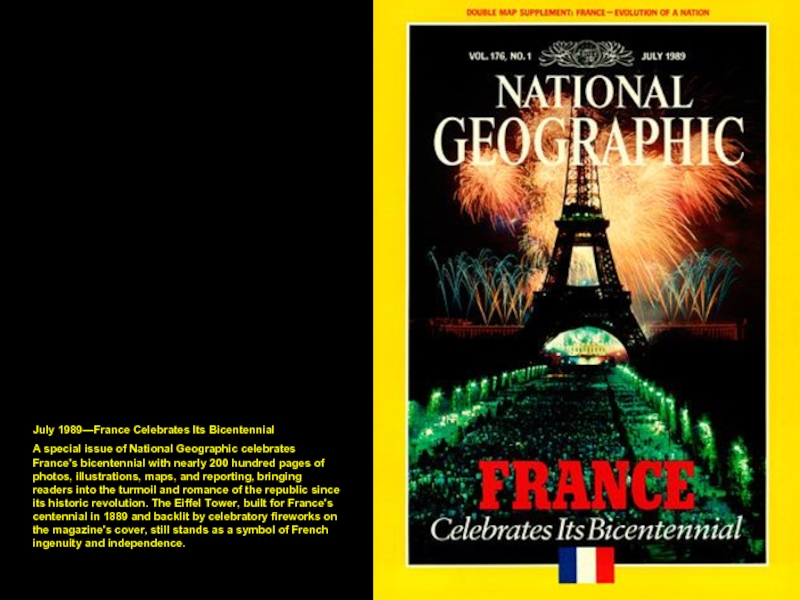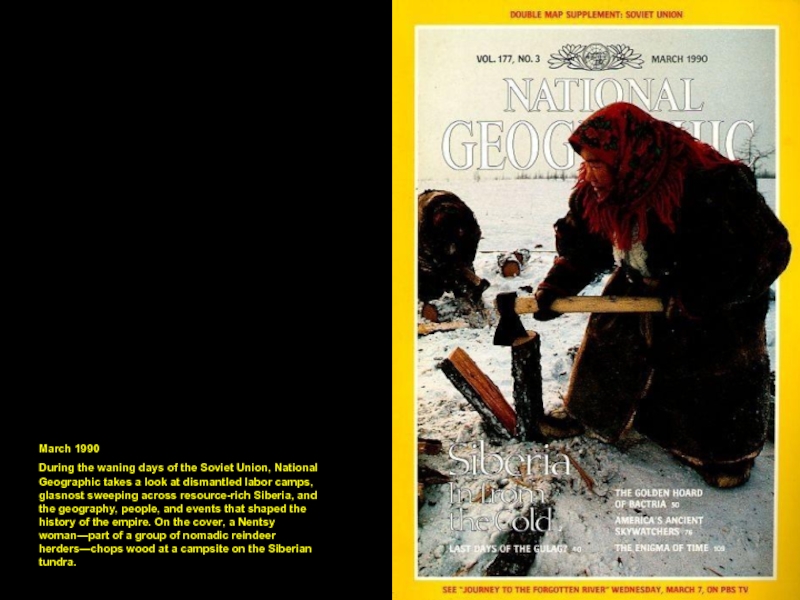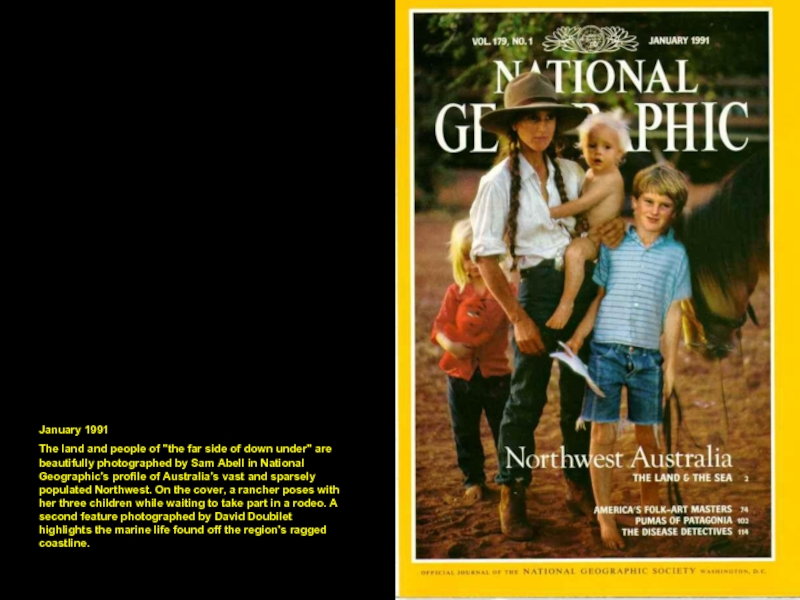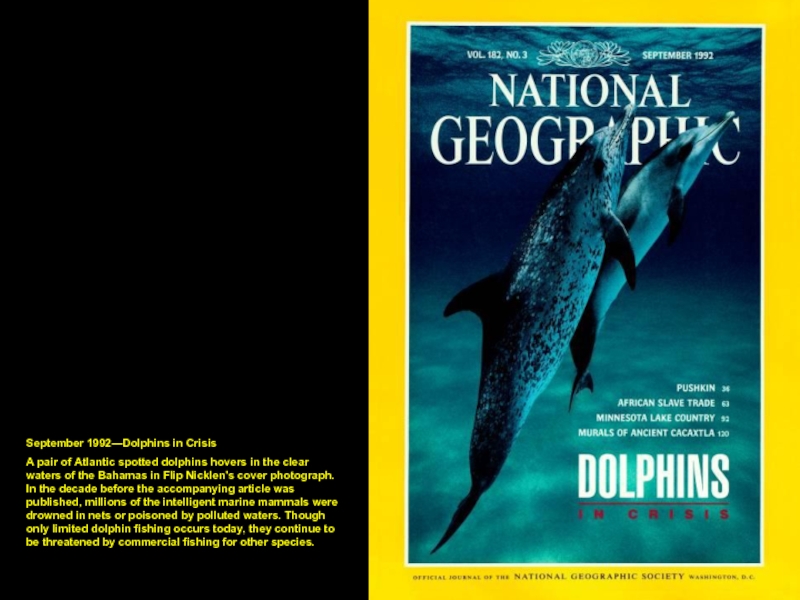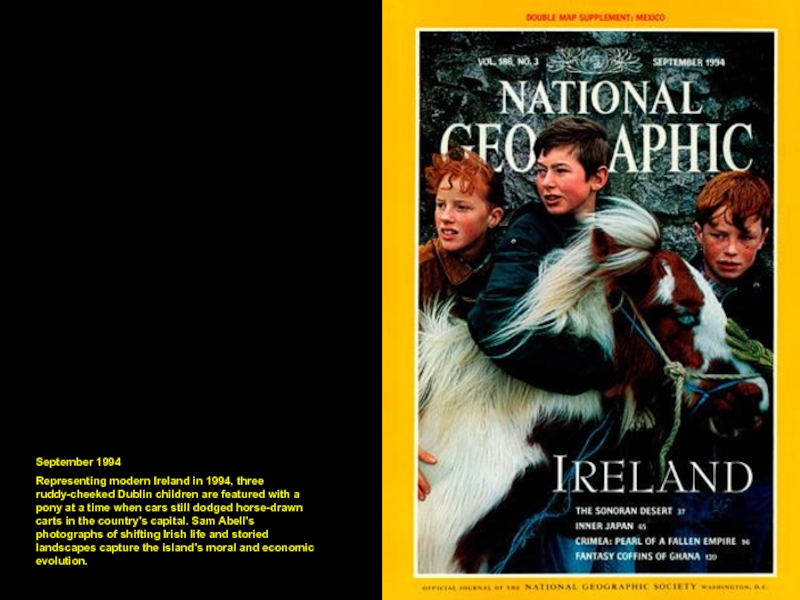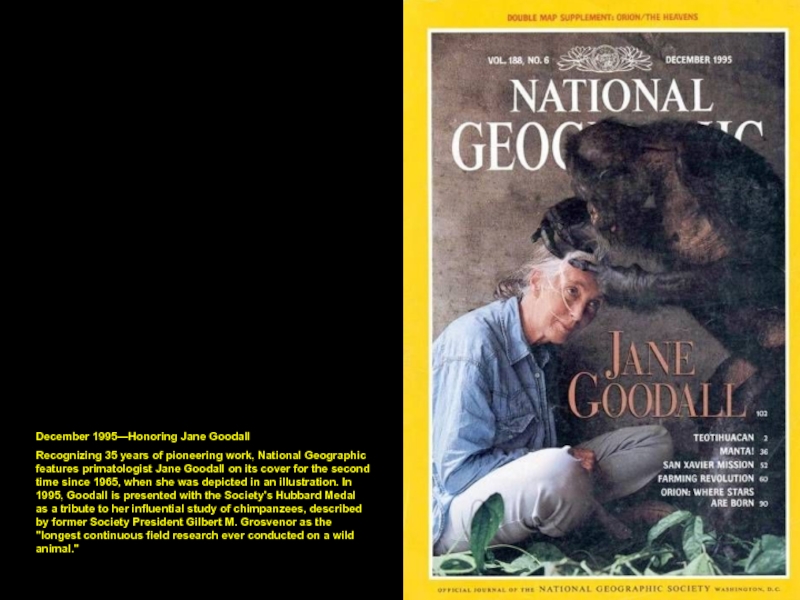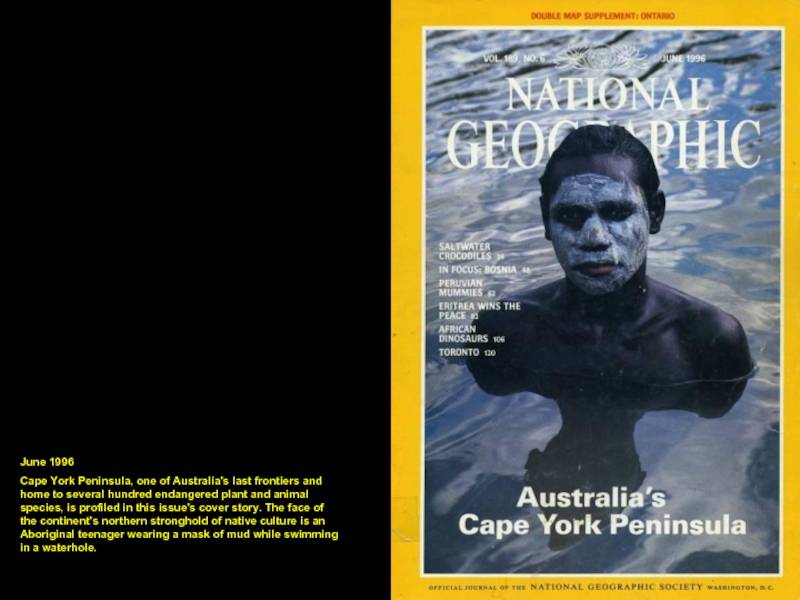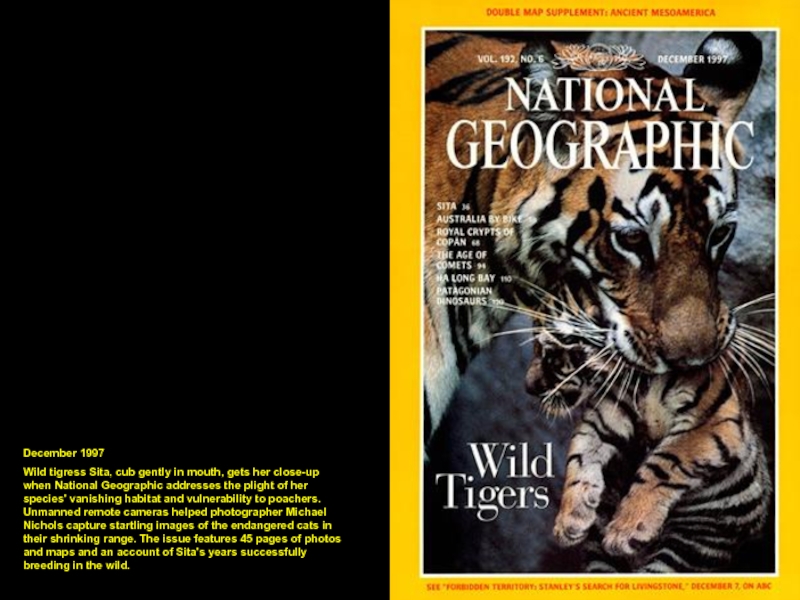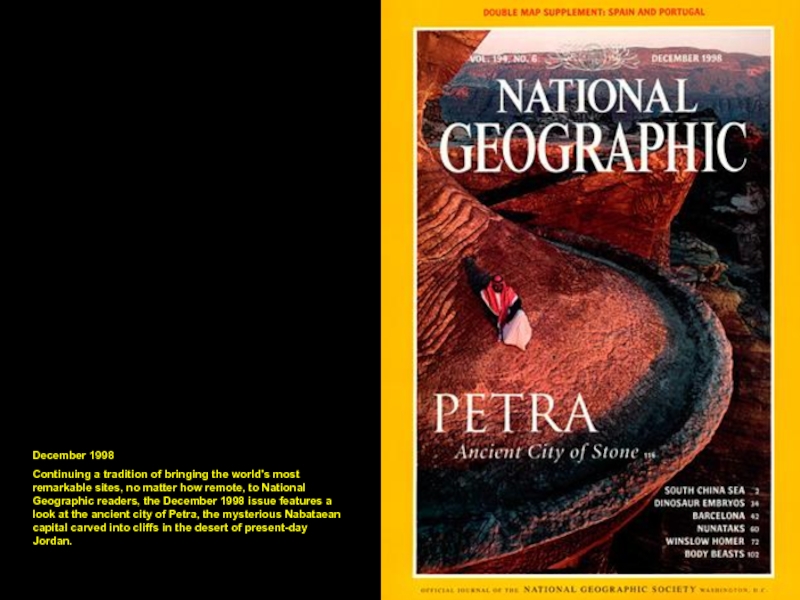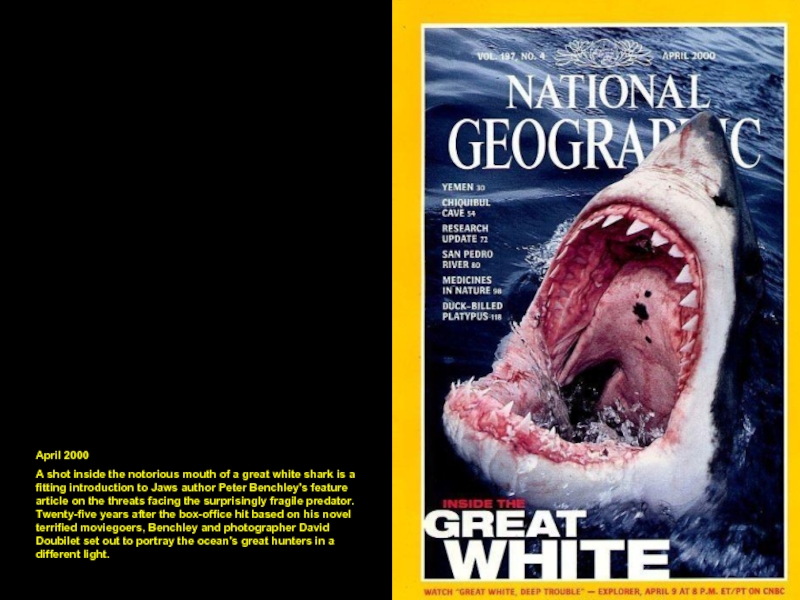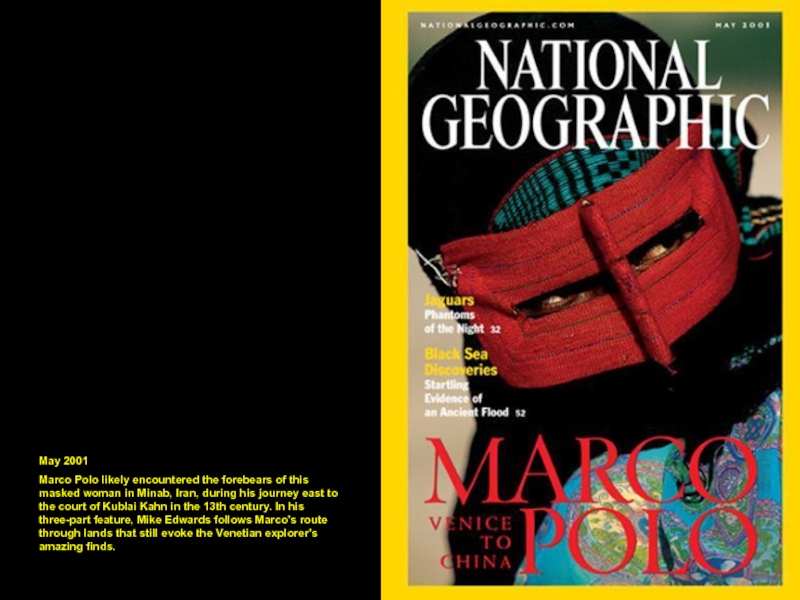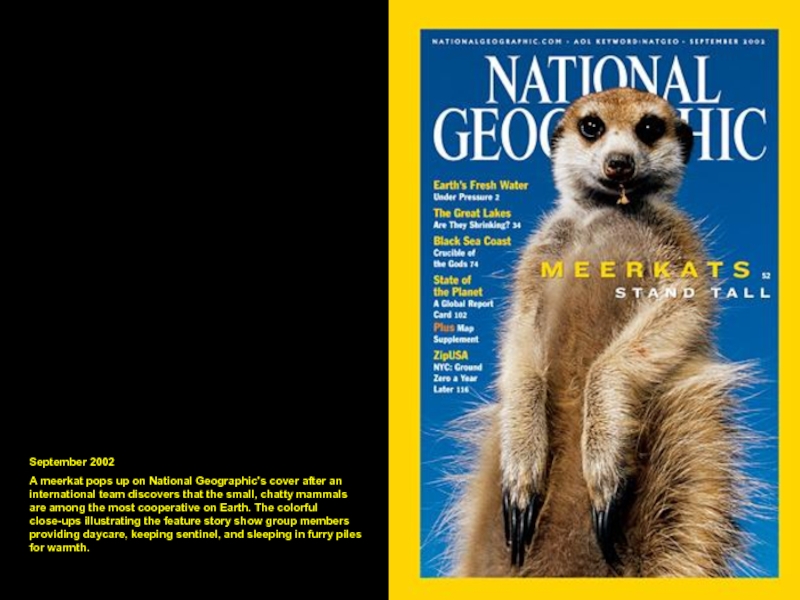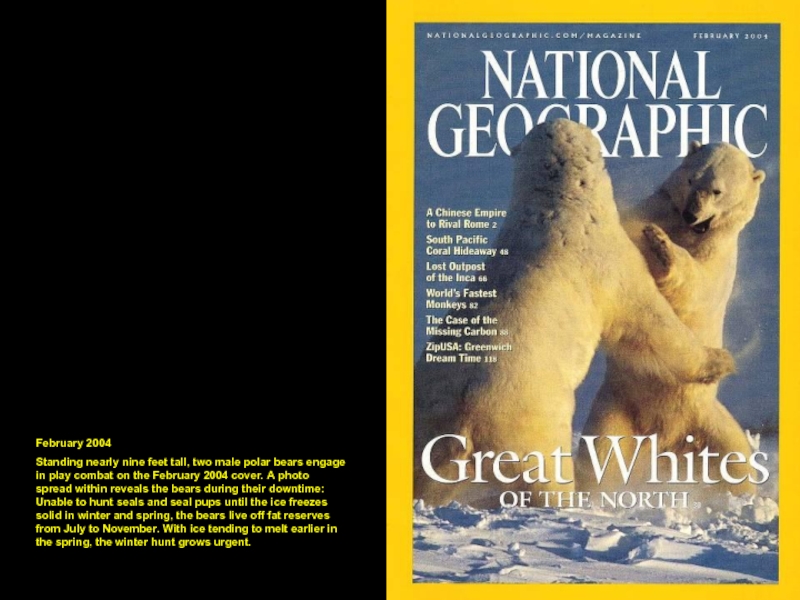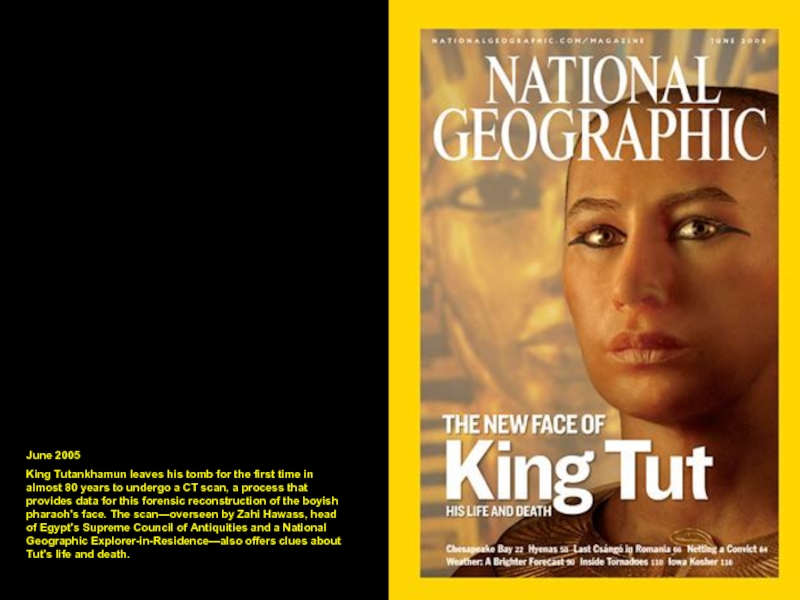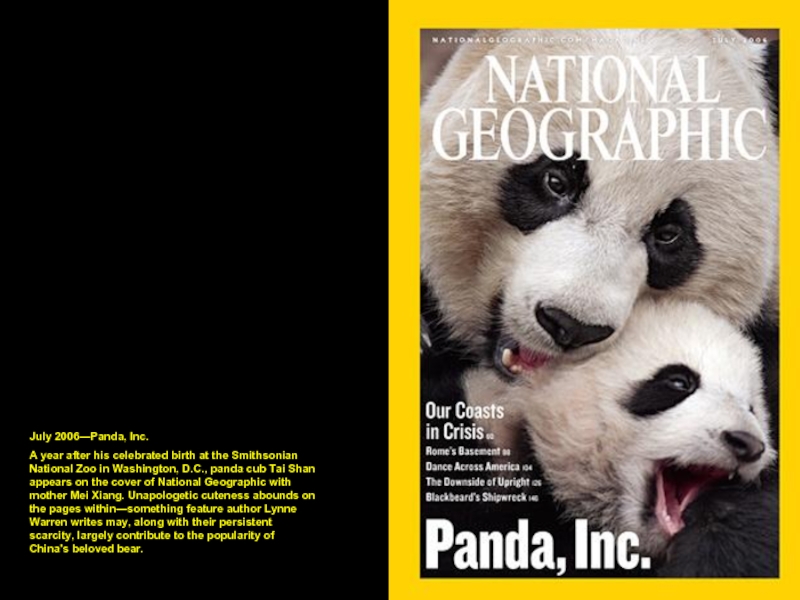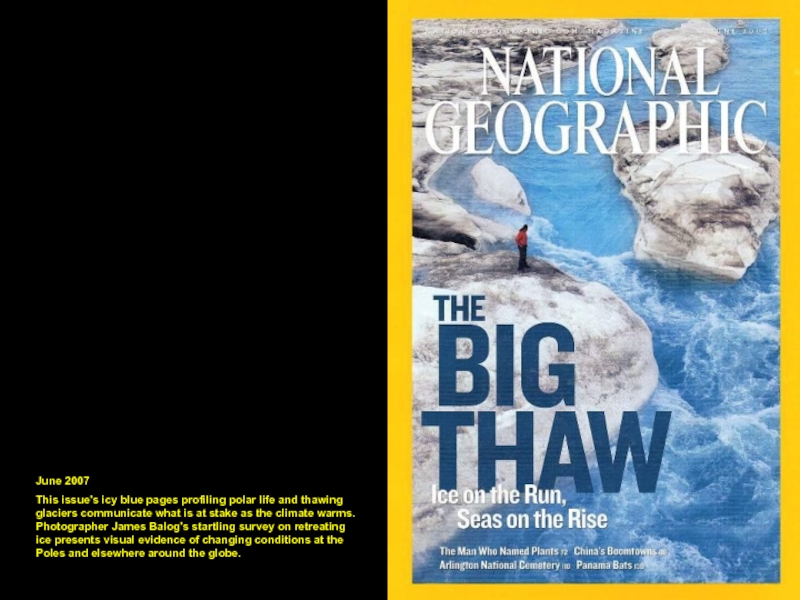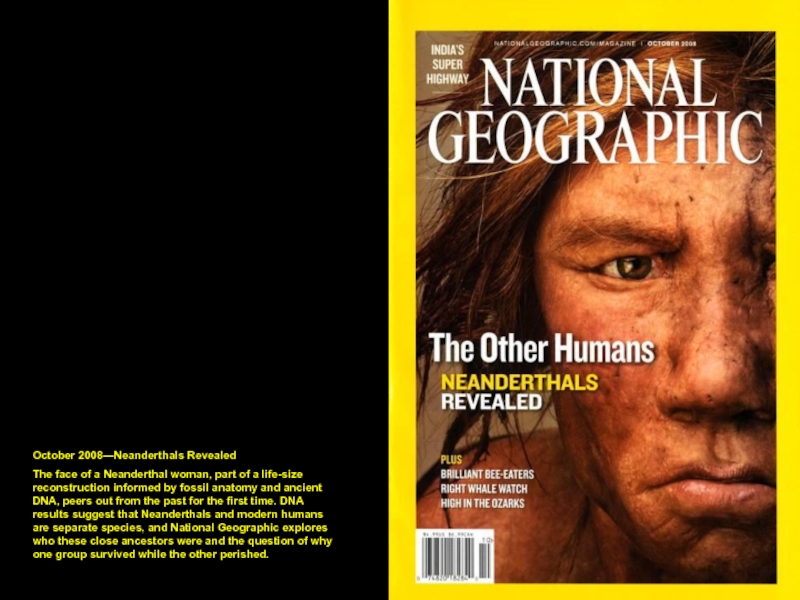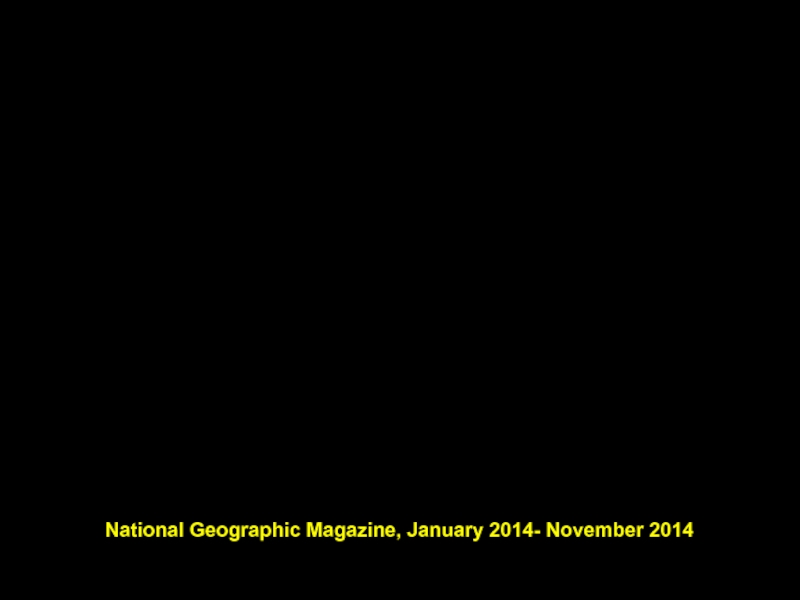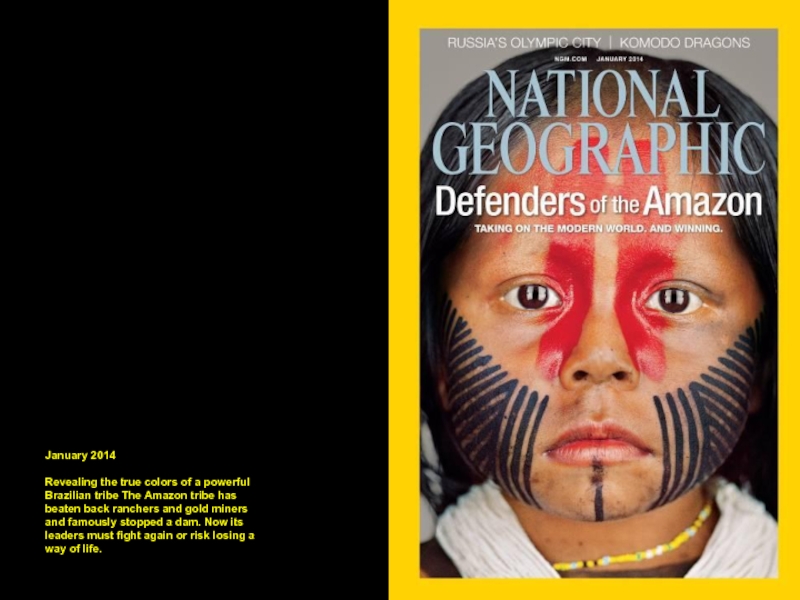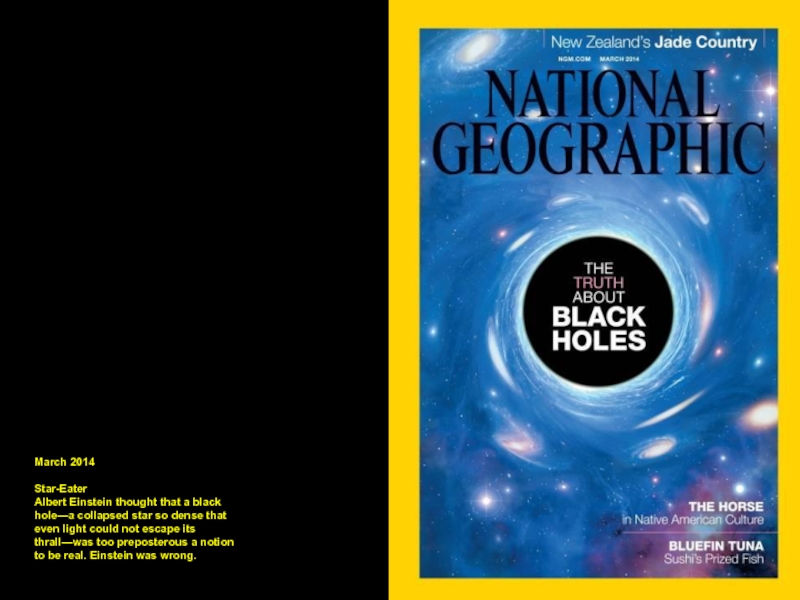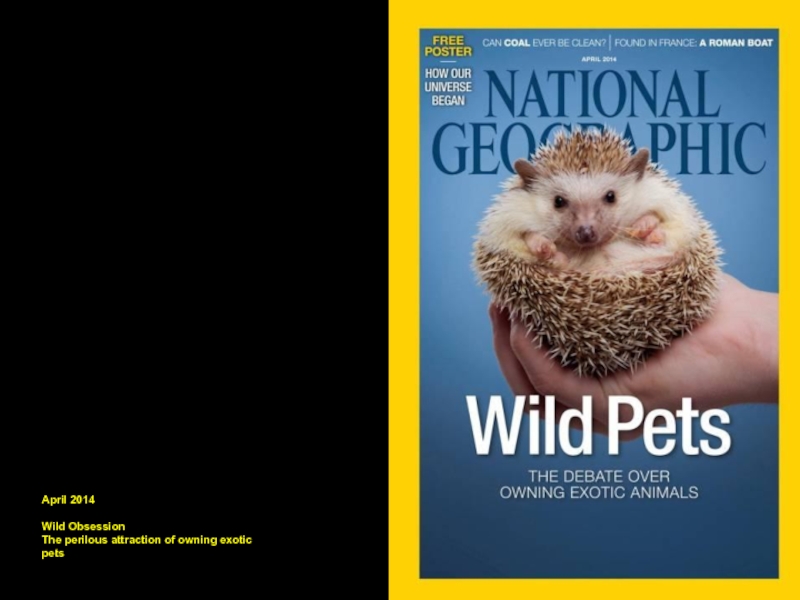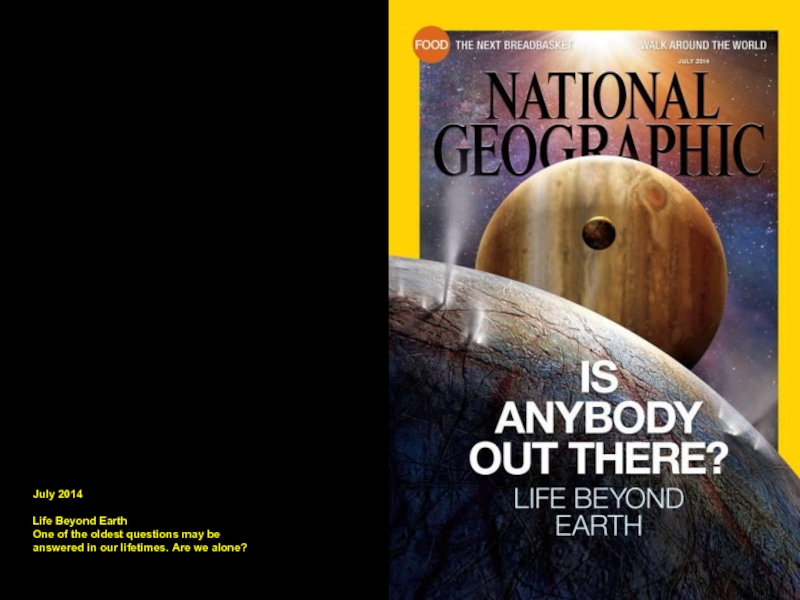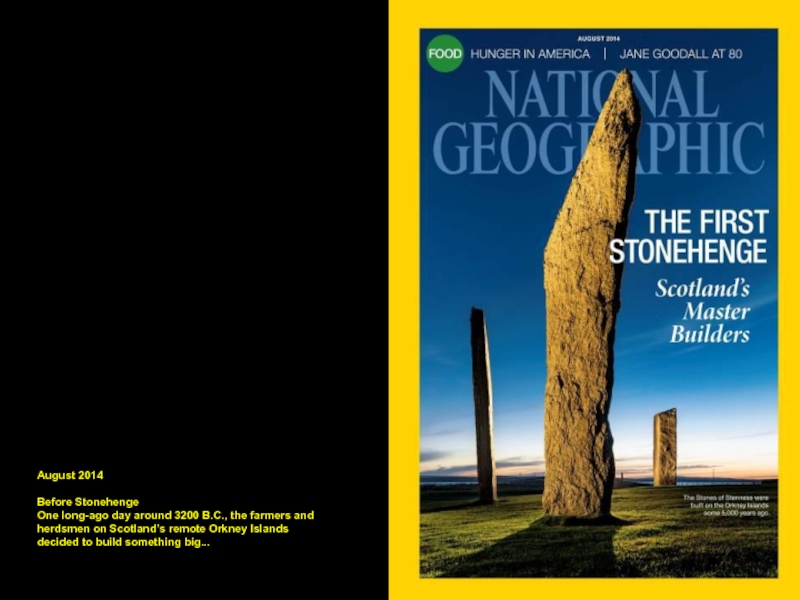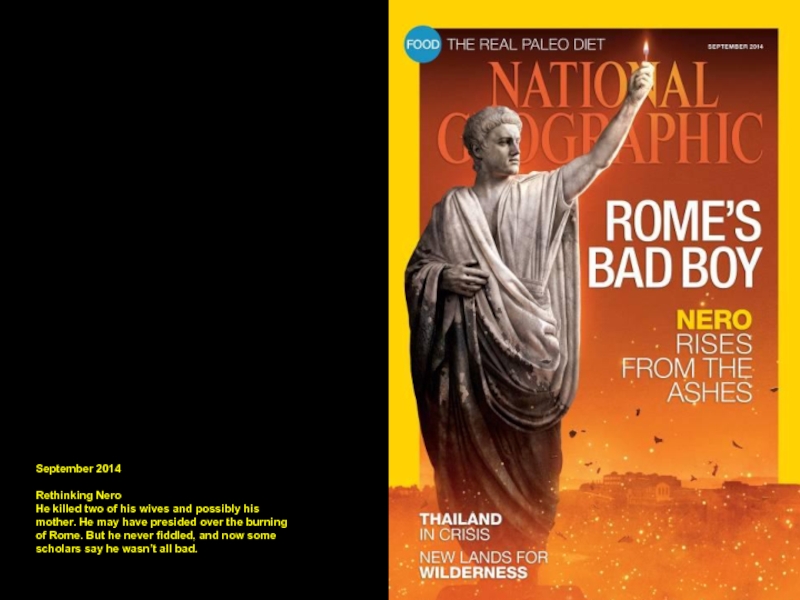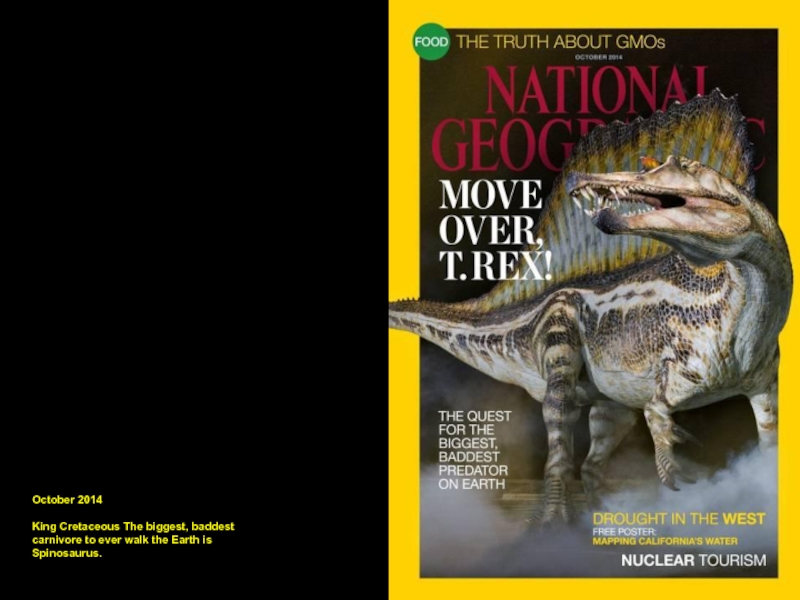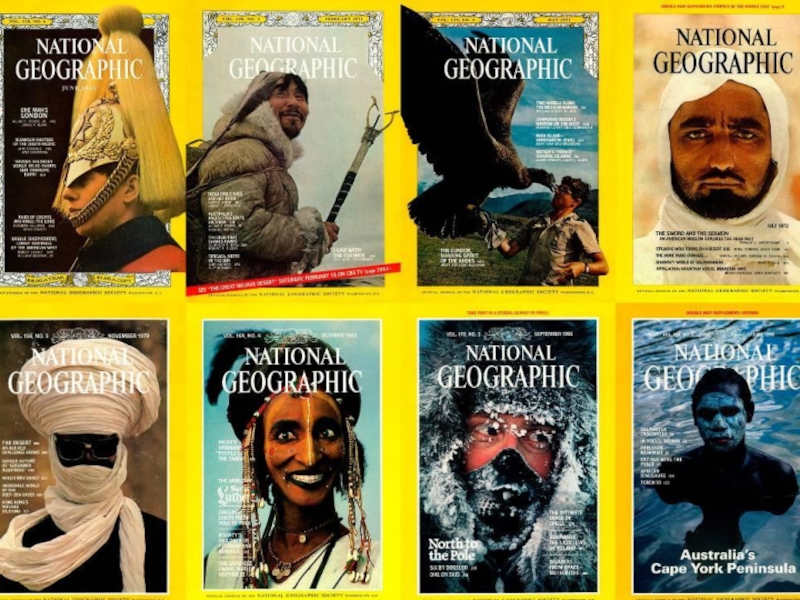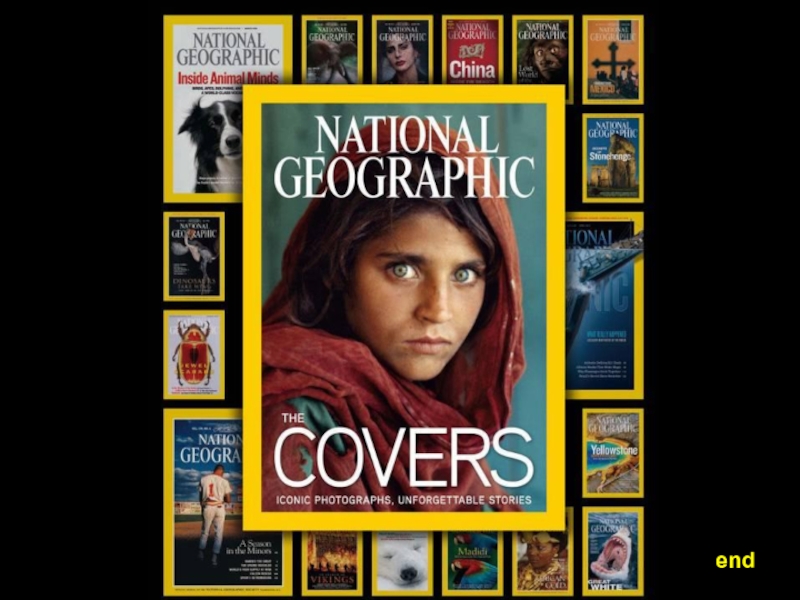- Главная
- Разное
- Дизайн
- Бизнес и предпринимательство
- Аналитика
- Образование
- Развлечения
- Красота и здоровье
- Финансы
- Государство
- Путешествия
- Спорт
- Недвижимость
- Армия
- Графика
- Культурология
- Еда и кулинария
- Лингвистика
- Английский язык
- Астрономия
- Алгебра
- Биология
- География
- Детские презентации
- Информатика
- История
- Литература
- Маркетинг
- Математика
- Медицина
- Менеджмент
- Музыка
- МХК
- Немецкий язык
- ОБЖ
- Обществознание
- Окружающий мир
- Педагогика
- Русский язык
- Технология
- Физика
- Философия
- Химия
- Шаблоны, картинки для презентаций
- Экология
- Экономика
- Юриспруденция
Best National Geographic Magazine Covers презентация
Содержание
- 2. Best National Geographic Magazine Covers
- 3. These best National Geographic covers span the
- 4. July 1959—First Photograph Appears on the Cover
- 5. April 1960—Jacques Cousteau and National Geographic Less
- 6. January 1961—The White House At the end
- 7. June 1962—John Glenn Orbits the Earth Friendship
- 8. October 1963—75th Anniversary Issue Celebrating 75 years
- 9. July 1964—Redwoods: Tallest Tree Discovered Conveying the
- 10. August 1965—Remembering Winston Churchill Following the death
- 11. March 1966 Built by Ivan the Terrible
- 12. January 1967 Dressed for Eid al-Fitr festivities,
- 13. October 1968 Sixteen-year-old Robin Lee Graham, featured
- 14. December 1969—Apollo 11 Moon Landing Neil Armstrong's
- 15. December 1970—Our Ecological Crisis A western grebe
- 16. November 1971—Antarctica In the service of science,
- 17. July 1972 To bring knowledge and understanding
- 18. March 1973 The last whale hunters in
- 19. October 1974 With his great-great-grandfather's five-colored
- 20. March 1975 After collecting a sample of
- 21. December 1976 A fleet of ships, some
- 22. February 1977 Displaying the American flag and
- 23. March 1978 Inhabitant of the last Shangri-la,
- 24. September 1979 An array of stone points,
- 25. November 1980 A snow shower dusts Windsor
- 26. August 1981 A 1,200-year-old cave painting of
- 27. May 1982 In the fall of 1981,
- 28. July 1983 Outfitted in a WASP suit,
- 29. May 1984—New Discoveries at Pompeii and Herculaneum
- 30. June 1985—Afghan Girl When photographer Steve McCurry
- 31. June 1986 A female snow leopard takes
- 32. October 1987—Women of Saudi Arabia Photographer Jodi
- 33. January 1988—One Hundred Years From Robert E.
- 34. July 1989—France Celebrates Its Bicentennial A special
- 35. March 1990 During the waning days of
- 36. January 1991 The land and people of
- 37. September 1992—Dolphins in Crisis A pair of
- 38. April 1993—Andrew Aftermath After meeting at a
- 39. September 1994 Representing modern Ireland in
- 40. December 1995—Honoring Jane Goodall Recognizing 35 years
- 41. June 1996 Cape York Peninsula, one of
- 42. December 1997 Wild tigress Sita, cub gently
- 43. December 1998 Continuing a tradition of bringing
- 44. August 1999—Global Culture Near the end
- 45. April 2000 A shot inside the notorious
- 46. May 2001 Marco Polo likely encountered the
- 47. September 2002 A meerkat pops up on
- 48. July 2003—Divided Korea Fifty years after the
- 49. February 2004 Standing nearly nine feet tall,
- 50. June 2005 King Tutankhamun leaves his tomb
- 51. July 2006—Panda, Inc. A year after his
- 52. June 2007 This issue's icy blue pages
- 53. October 2008—Neanderthals Revealed The face of a
- 54. October 2009—Redwoods For the October 2009 article
- 55. September 2010 King Tut's Family Secrets
- 56. July 2011 The Search for
- 57. February 2012 How to Build
- 58. April 2013 Of Mammoths and
- 59. National Geographic Magazine, January 2014- November 2014
- 60. January 2014 Revealing the true
- 61. February 2014 Secrets of the Brain
- 62. March 2014 Star-Eater Albert Einstein thought
- 63. April 2014 Wild Obsession The perilous attraction of owning exotic pets
- 64. May 2014 Feeding Nine Billion To
- 65. June 2014 The Dogs of War
- 66. July 2014 Life Beyond Earth One
- 67. August 2014 Before Stonehenge One long-ago
- 68. September 2014 Rethinking Nero He killed
- 69. October 2014 King Cretaceous The biggest,
- 70. October 2014 Body-snatched zombie ladybugs! It’s not
- 72. end
- 73. cast
Слайд 3These best National Geographic covers span the entire history of the
publication, and provide a good overview of the stories and issues National Geographic has covered over the years. Iconic magazine covers capture images of historic and cultural landmarks that persist in the collective consciousness.
National Geographic is the monthly journal of the National Geographic Society, currently printed in 34 languages around the world. First printed in 1888, the magazine features articles about physical and human geography around the world. National Geographic is famous for its eye-opening photography stories about cultures and crises that are ignored or skewed by other publications.
National Geographic is the monthly journal of the National Geographic Society, currently printed in 34 languages around the world. First printed in 1888, the magazine features articles about physical and human geography around the world. National Geographic is famous for its eye-opening photography stories about cultures and crises that are ignored or skewed by other publications.
Слайд 4July 1959—First Photograph Appears on the Cover
Seventy years after its founding
in 1888, the National Geographic Society introduces the first photograph on the cover of its increasingly popular journal. Following a tradition of American flag covers in July that began during World War II, the July 1959 issue features the new, 49-star banner. Alaska, admitted to the Union in January 1959, is profiled in several articles, and a map of the newest state is included as a supplement with the issue.
Слайд 5April 1960—Jacques Cousteau and National Geographic
Less than a year after the
first photograph appears on National Geographic, a jet-propelled diving saucer appears on the April 1960 cover. The underwater test of a new submarine is the most recent in a series of National Geographic Society-Calypso expeditions led by Capt. Jacques-Yves Cousteau, a partnership of ocean exploration that began in 1950 and continued for 15 years.
Слайд 6January 1961—The White House
At the end of the eight-year Eisenhower presidency,
First Lady Mamie Eisenhower introduces the National Geographic article "Inside the White House." The mansion's famous façade is featured on the issue's cover, photographed at dusk and standing ready to welcome its next residents—President John F. Kennedy and his family.
Слайд 7June 1962—John Glenn Orbits the Earth
Friendship 7 rockets across the cover
of National Geographic after John Glenn's historic orbital voyage. Glenn agreed to carry a small National Geographic flag on his journey, returning it to the Society in April 1962. National Geographic photographer Dean Conger's photos of Friendship 7's recovery from the ocean were featured in the issue and published around the world.
Слайд 8October 1963—75th Anniversary Issue
Celebrating 75 years of publication National Geographic magazine—in
its largest issue to date—recounts the Society's triumphs in exploration and discovery, including in-depth reports on the first American conquest of Mount Everest and the rescue of Nile antiquities. The special issue also presents a retrospective on photographic firsts and an essay by former President and Editor Gilbert H. Grosvenor on "The Romance of the Geographic."
Слайд 9July 1964—Redwoods: Tallest Tree Discovered
Conveying the tallest redwood's awesome height requires
the full length of the magazine's cover. Long involved in redwood conservation efforts, National Geographic presents the findings of staff naturalist Paul Zahl, who discovered the tallest of the tallest trees, a redwood reaching 367 feet. The cover design—featuring a rare break in the famous yellow border—is echoed in the October 2009 issue.
Слайд 10August 1965—Remembering Winston Churchill
Following the death of Sir Winston Churchill, former
President Dwight D. Eisenhower introduces National Geographic's tribute to the British prime minister, featured on the issue's cover. The 70-page tribute includes photos, recollections, and a look at Churchill's political life and personal achievements.
Слайд 11March 1966
Built by Ivan the Terrible in the 16th century, St.
Basil's Cathedral in Moscow embodies the splendor and mystique of old Russia. The capital city is profiled in depth by writer Thomas T. Hammond, with photographs by Dean Conger that illustrate urban life in the Soviet Union of the mid-1960s.
Слайд 12January 1967
Dressed for Eid al-Fitr festivities, two young girls play on
a swing in Pakistan, then made up of two lands located on opposite sides of the Indian subcontinent. The cover's traditional interior border of oak leaves and acorns, first introduced in 1910, begins to recede around the increasingly bold feature photographs.
Слайд 13October 1968
Sixteen-year-old Robin Lee Graham, featured on the cover aboard his
fiberglass sloop, recounts his journey to become the youngest person to sail solo around the world.
Слайд 14December 1969—Apollo 11 Moon Landing
Neil Armstrong's famous photo of Edwin "Buzz"
Aldrin walking across the surface of the moon lands on the cover of National Geographic five months after the astronauts' historic voyage. Like John Glenn before him, Armstrong carried a small National Geographic flag to the moon and back, which he presented to Society President Melvin Payne when the Apollo 11 crew was awarded the Hubbard Medal in 1970.
Слайд 15December 1970—Our Ecological Crisis
A western grebe wears a fatal coat of
oil from a spill off California in 1969. The issue's series of articles on the ecological crisis is the first full-blown National Geographic contribution to growing concerns over the state of the environment, calling attention to the fragility of the planet under the strain of the growing human population. It is the last issue for retiring magazine Editor Frederick G. Vosburgh, who pushed daringly into the controversial field of ecology.
Слайд 16November 1971—Antarctica
In the service of science, a gentoo penguin waddles through
the Antarctica snow wearing a radio backpack that monitors its blood flow and pressure. "Antarctica's Nearer Side" continues National Geographic's long history of exploration on the continent, beginning with support for Robert E. Byrd's pioneering expeditions in the 1920s and '30s. The issue also features the first photographs of snow leopards in the wild.
Слайд 17July 1972
To bring knowledge and understanding at a time of conflict
and tension, National Geographic prints "The Sword and the Sermon," an American Muslim's account of his yearlong, 22-country exploration of Arab history and culture. An accompanying map supplement expands on the region's language, politics, land use, and physical geography.
Слайд 18March 1973
The last whale hunters in the United States, native Alaskans
ply slushy waters off the state's coast in a walrus-skin boat. The cover story follows the hunt for a bowhead whale and includes a report on the fight for traditional whaling rights, answered by Congress with an exemption written into the Marine Mammal Protection Act in 1972.
Слайд 19October 1974
With his great-great-grandfather's five-colored scarf on his shoulders, 18-year-old Jigme
Singye Wangchuck formally becomes monarch in the tiny kingdom of Bhutan. John Scofield's picture story highlights the color and enduring traditions of the sequestered nation. A second feature in the issue presents remarkable photos of the Earth and sun taken from Skylab.
Слайд 20March 1975
After collecting a sample of fresh spatter, a geologist is
silhouetted against a fountain of molten lava spouting from Hawaii's Mauna Ulu. Photos within the magazine reveal the natural contrasts of Hawaii's Big Island, built over eons by lava flows welling up from the ocean floor.
Слайд 21December 1976
A fleet of ships, some colliding, begin a race from
Bermuda to Newport, Rhode Island, to honor the U.S. Bicentennial in this cover photograph by Gilbert M. Grosvenor, Editor of the magazine for a decade before assuming the presidency of the National Geographic Society in 1980. The issue also features a double supplement on the "Whales of the World," and Grosvenor concludes his editor's note with "hope for a better day for both whales and men."
Слайд 22February 1977
Displaying the American flag and the flag of the National
Geographic Society, the Silver Fox drifts above the Gulf of St. Lawrence at the start of Ed Yost's record-breaking transatlantic journey. His article for National Geographic details the challenges he undertook to achieve the longest manned balloon flight.
Слайд 23March 1978
Inhabitant of the last Shangri-la, a young Ladakhi woman wears
a turquoise-covered insignia of wealth. Four years after India opens Ladakh to foreign visitors, National Geographic explores the lost valleys that were for centuries isolated by the rigors of Himalayan travel.
Слайд 24September 1979
An array of stone points, knives, and bone spear parts
date to Ice Age hunters roaming Montana 11,000 years ago. National Geographic's "Search for the First Americans" uses photos, maps, and illustrations to create a time line of the earliest human activity in the Americas. As introduced on the July 1979 cover, the oak leaf interior border crowning the magazine's title is replaced by a single garland, which remains on the cover until the end of the millennium.
Слайд 25November 1980
A snow shower dusts Windsor Castle as Prince Phillip drives
a four-in-hand toward the Long Walk. In its profile of the 900-year-old fortress, National Geographic includes images of the young Charles, Prince of Wales; the interior grandeur of Windsor; and the miniature charm of the Queen's Dolls' House, built for Queen Mary in the 1920s.
Слайд 26August 1981
A 1,200-year-old cave painting of a Maya ballplayer is a
recent find when it appears on the August 1981 cover of National Geographic. Discovered in a remote cavern in Guatemala, the artworks and writings of the ancient Maya identify dates and notables of the Classic period.
Слайд 27May 1982
In the fall of 1981, following a decade of atrocities
committed by the Khmer Rouge regime, National Geographic traveled inside Vietnamese-controlled areas of what is now Cambodia to report on the condition of the vast complex of crumbling temples and sculptures—including the deity featured on the May 1982 cover—at Angkor Wat, the sacred site first glimpsed in the magazine in 1912 and featured recently in a July 2009 cover story.
Слайд 28July 1983
Outfitted in a WASP suit, Phil Nuytten is the first
man to dive on the northernmost shipwreck ever discovered on the seafloor. The British Breadalbane was lost beneath the Arctic ice while aiding in the search for survivors of the ill-fated Franklin Expedition. Both the submersible WASP suit and the photographs taken by a National Geographic camera mounted on a remotely piloted vehicle are revolutionary devices for exploring the deep.
Слайд 29May 1984—New Discoveries at Pompeii and Herculaneum
Her bones preserved in Herculaneum's
volcanic tomb for nearly 2,000 years, a Roman woman is still adorned in rings of gold, carnelian, and jasper. Two years after macabre new relics are discovered at the site of the ancient seaside town, National Geographic provides haunting photos and new details on the long-dead victims of Vesuvius.
Слайд 30June 1985—Afghan Girl
When photographer Steve McCurry took a young girl's picture
one morning in Pakistan, he created an image that would captivate millions around the world. The haunting green eyes that stared out from the June 1985 cover of National Geographic belonged to an unknown refugee who for 17 years was identified simply as the "Afghan girl." She has since been located and was once again featured on the magazine's cover in April 2002.
Слайд 31June 1986
A female snow leopard takes an inadvertent self-portrait when she
triggers a hidden camera, a resource that provided researchers—and National Geographic readers—with rare photographic coverage of the shy, solitary, and elusive cat. In the last 20 years, her species has not escaped its endangered status, today numbering only around 6,000 in the wild.
Слайд 32October 1987—Women of Saudi Arabia
Photographer Jodi Cobb captures a child's present
and future for National Geographic's landmark 1987 article on the women of Saudi Arabia. Created in the palaces of princesses and in the tents of Bedouin, Cobb's images shed rare light on one of the world's most conservative societies.
Слайд 33January 1988—One Hundred Years
From Robert E. Peary's expedition to the North
Pole to the discovery of the Titanic, National Geographic highlights a century of exploration on its centennial cover. The special issue includes a reprint of the introductory address by founding President Gardiner Greene Hubbard, a glimpse back at the Victorian era into which the Society was born, and a look at those who are carrying on the tradition, "that we may all know more of the world."
Слайд 34July 1989—France Celebrates Its Bicentennial
A special issue of National Geographic celebrates
France's bicentennial with nearly 200 hundred pages of photos, illustrations, maps, and reporting, bringing readers into the turmoil and romance of the republic since its historic revolution. The Eiffel Tower, built for France's centennial in 1889 and backlit by celebratory fireworks on the magazine's cover, still stands as a symbol of French ingenuity and independence.
Слайд 35March 1990
During the waning days of the Soviet Union, National Geographic
takes a look at dismantled labor camps, glasnost sweeping across resource-rich Siberia, and the geography, people, and events that shaped the history of the empire. On the cover, a Nentsy woman—part of a group of nomadic reindeer herders—chops wood at a campsite on the Siberian tundra.
Слайд 36January 1991
The land and people of "the far side of down
under" are beautifully photographed by Sam Abell in National Geographic's profile of Australia's vast and sparsely populated Northwest. On the cover, a rancher poses with her three children while waiting to take part in a rodeo. A second feature photographed by David Doubilet highlights the marine life found off the region's ragged coastline.
Слайд 37September 1992—Dolphins in Crisis
A pair of Atlantic spotted dolphins hovers in
the clear waters of the Bahamas in Flip Nicklen's cover photograph. In the decade before the accompanying article was published, millions of the intelligent marine mammals were drowned in nets or poisoned by polluted waters. Though only limited dolphin fishing occurs today, they continue to be threatened by commercial fishing for other species.
Слайд 38April 1993—Andrew Aftermath
After meeting at a Florida relief center, Marine David
Ketchum and three-year-old Jarvis Williams embody both the struggle and unity that followed the destruction wrought by Hurricane Andrew in the summer of 1992. With stunning photographs and personal stories, National Geographic recounts the devastation of what was then America's most destructive storm.
Слайд 39September 1994
Representing modern Ireland in 1994, three ruddy-cheeked Dublin children
are featured with a pony at a time when cars still dodged horse-drawn carts in the country's capital. Sam Abell's photographs of shifting Irish life and storied landscapes capture the island's moral and economic evolution.
Слайд 40December 1995—Honoring Jane Goodall
Recognizing 35 years of pioneering work, National Geographic
features primatologist Jane Goodall on its cover for the second time since 1965, when she was depicted in an illustration. In 1995, Goodall is presented with the Society's Hubbard Medal as a tribute to her influential study of chimpanzees, described by former Society President Gilbert M. Grosvenor as the "longest continuous field research ever conducted on a wild animal."
Слайд 41June 1996
Cape York Peninsula, one of Australia's last frontiers and home
to several hundred endangered plant and animal species, is profiled in this issue's cover story. The face of the continent's northern stronghold of native culture is an Aboriginal teenager wearing a mask of mud while swimming in a waterhole.
Слайд 42December 1997
Wild tigress Sita, cub gently in mouth, gets her close-up
when National Geographic addresses the plight of her species' vanishing habitat and vulnerability to poachers. Unmanned remote cameras helped photographer Michael Nichols capture startling images of the endangered cats in their shrinking range. The issue features 45 pages of photos and maps and an account of Sita's years successfully breeding in the wild.
Слайд 43December 1998
Continuing a tradition of bringing the world's most remarkable sites,
no matter how remote, to National Geographic readers, the December 1998 issue features a look at the ancient city of Petra, the mysterious Nabataean capital carved into cliffs in the desert of present-day Jordan.
Слайд 44August 1999—Global Culture
Near the end of the millennium, a mother and
daughter are a study in contrasts as they represent the new global culture, the subject of this special issue that examines cultures emerging and vanishing amid the increased exchange of information, products, and ideas. This year is the last in which the magazine's cover still features a crown of laurels, the final remnant of the oak leaf border first introduced in 1910.
Слайд 45April 2000
A shot inside the notorious mouth of a great white
shark is a fitting introduction to Jaws author Peter Benchley's feature article on the threats facing the surprisingly fragile predator. Twenty-five years after the box-office hit based on his novel terrified moviegoers, Benchley and photographer David Doubilet set out to portray the ocean's great hunters in a different light.
Слайд 46May 2001
Marco Polo likely encountered the forebears of this masked woman
in Minab, Iran, during his journey east to the court of Kublai Kahn in the 13th century. In his three-part feature, Mike Edwards follows Marco's route through lands that still evoke the Venetian explorer's amazing finds.
Слайд 47September 2002
A meerkat pops up on National Geographic's cover after an
international team discovers that the small, chatty mammals are among the most cooperative on Earth. The colorful close-ups illustrating the feature story show group members providing daycare, keeping sentinel, and sleeping in furry piles for warmth.
Слайд 48July 2003—Divided Korea
Fifty years after the end of the Korean War,
National Geographic goes inside the Demilitarized Zone, the cease-fire line where soldiers from north and south of the 38th parallel face off in a tense display of might and will—a reminder that a half century of fragile peace could be broken at any moment.
Слайд 49February 2004
Standing nearly nine feet tall, two male polar bears engage
in play combat on the February 2004 cover. A photo spread within reveals the bears during their downtime: Unable to hunt seals and seal pups until the ice freezes solid in winter and spring, the bears live off fat reserves from July to November. With ice tending to melt earlier in the spring, the winter hunt grows urgent.
Слайд 50June 2005
King Tutankhamun leaves his tomb for the first time in
almost 80 years to undergo a CT scan, a process that provides data for this forensic reconstruction of the boyish pharaoh's face. The scan—overseen by Zahi Hawass, head of Egypt's Supreme Council of Antiquities and a National Geographic Explorer-in-Residence—also offers clues about Tut's life and death.
Слайд 51July 2006—Panda, Inc.
A year after his celebrated birth at the Smithsonian
National Zoo in Washington, D.C., panda cub Tai Shan appears on the cover of National Geographic with mother Mei Xiang. Unapologetic cuteness abounds on the pages within—something feature author Lynne Warren writes may, along with their persistent scarcity, largely contribute to the popularity of China's beloved bear.
Слайд 52June 2007
This issue's icy blue pages profiling polar life and thawing
glaciers communicate what is at stake as the climate warms. Photographer James Balog's startling survey on retreating ice presents visual evidence of changing conditions at the Poles and elsewhere around the globe.
Слайд 53October 2008—Neanderthals Revealed
The face of a Neanderthal woman, part of a
life-size reconstruction informed by fossil anatomy and ancient DNA, peers out from the past for the first time. DNA results suggest that Neanderthals and modern humans are separate species, and National Geographic explores who these close ancestors were and the question of why one group survived while the other perished.
Слайд 54October 2009—Redwoods
For the October 2009 article on Pacific Coast redwoods, photographer
Michael Nichols and his team create an unprecedented photographic portrait of a complete redwood tree, a mosaic made up of 87 images. The cover shot of the redwood trunk shooting through the yellow border is only part of the 300-foot-tall, 1,500-year-old titan. The full photo unfolds from within the magazine, revealing the most complex crown scientists have mapped.
Слайд 55September 2010
King Tut's Family Secrets To me the story of
Tutankhamun is like a play whose ending is still being written.
Слайд 56July 2011
The Search for Cleopatra Archaeologists search for the true
face-and the burial place-of the “world’s first celebrity.”
Слайд 57February 2012
How to Build a Dog
Scientists have found the secret
recipe behind the spectacular variety of dog shapes and sizes, and it could help unravel the complexity of human genetic disease.
Слайд 58April 2013
Of Mammoths and Men
Ancient hunters killed woolly mammoths for
their meat. Today in Russia’s Arctic the search is on for their valuable tusks.
Слайд 60January 2014
Revealing the true colors of a powerful Brazilian tribe
The Amazon tribe has beaten back ranchers and gold miners and famously stopped a dam. Now its leaders must fight again or risk losing a way of life.
Слайд 61February 2014
Secrets of the Brain
New technologies are shedding light on biology’s
greatest unsolved mystery: how the brain really works.
Слайд 62March 2014
Star-Eater
Albert Einstein thought that a black hole—a collapsed star so
dense that even light could not escape its thrall—was too preposterous a notion to be real. Einstein was wrong.
Слайд 64May 2014
Feeding Nine Billion
To feed our hungry planet, we must change
the way we farm—and the way we think.
Слайд 65June 2014
The Dogs of War
Out in front of America’s troops, combat
canines and their handlers lead the way onto the most dangerous battlefields on Earth.
Слайд 66July 2014
Life Beyond Earth
One of the oldest questions may be answered
in our lifetimes. Are we alone?
Слайд 67August 2014
Before Stonehenge
One long-ago day around 3200 B.C., the farmers and
herdsmen on Scotland’s remote Orkney Islands decided to build something big...
Слайд 68September 2014
Rethinking Nero
He killed two of his wives and possibly his
mother. He may have presided over the burning of Rome. But he never fiddled, and now some scholars say he wasn’t all bad.
Слайд 69October 2014
King Cretaceous The biggest, baddest carnivore to ever walk the
Earth is Spinosaurus.
Слайд 70October 2014
Body-snatched zombie ladybugs! It’s not science fiction, but a real
invasion of parasitic organisms.
Слайд 73cast
Best National Geographic Magazine Covers
images and text credit www.
ngm-beta.nationalgeographic.com
ngm.nationalgeographic.com
itcolossal.com
Music Vangelis
created o.e. thanks for watching
images and text credit www.
ngm-beta.nationalgeographic.com
ngm.nationalgeographic.com
itcolossal.com
Music Vangelis
created o.e. thanks for watching
